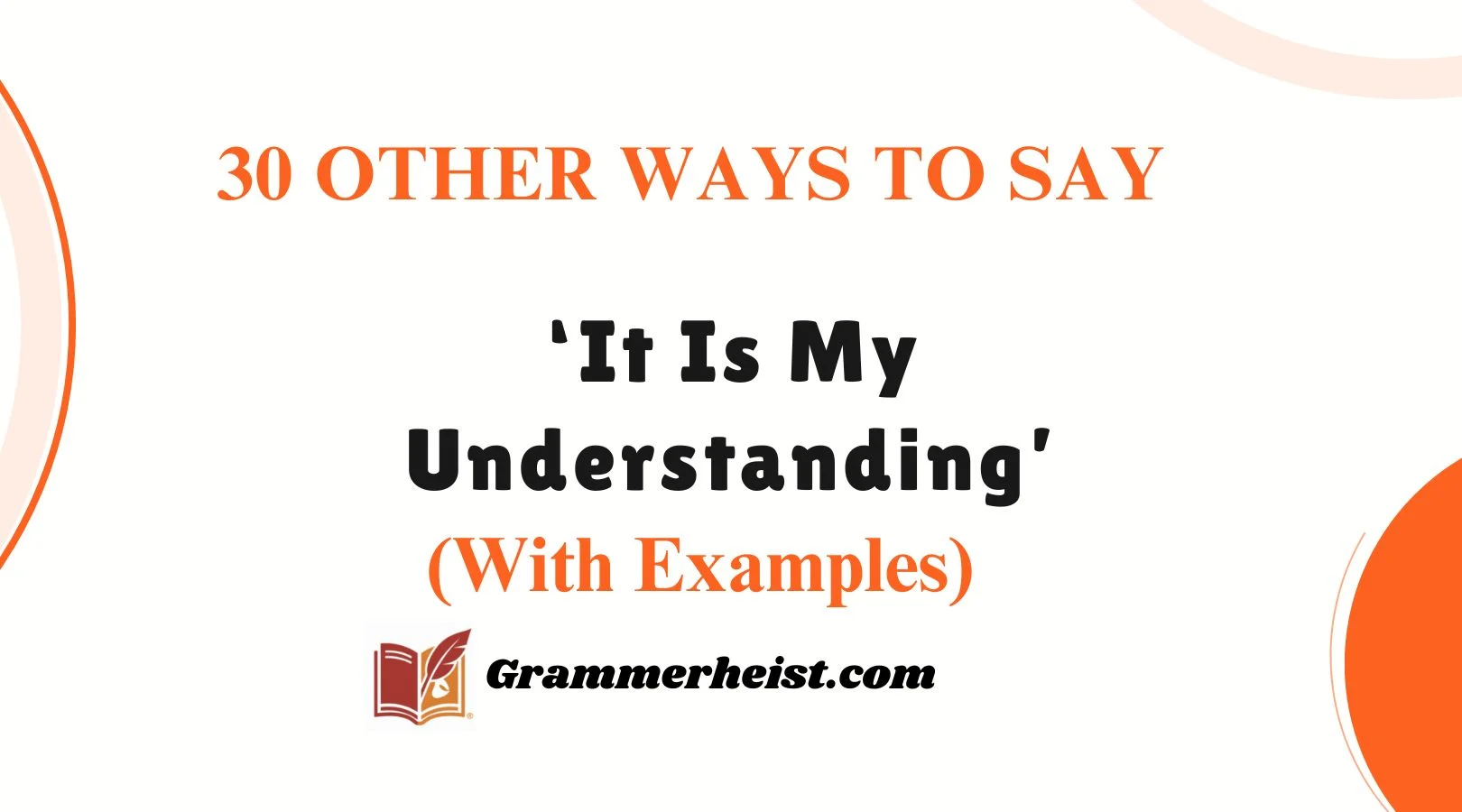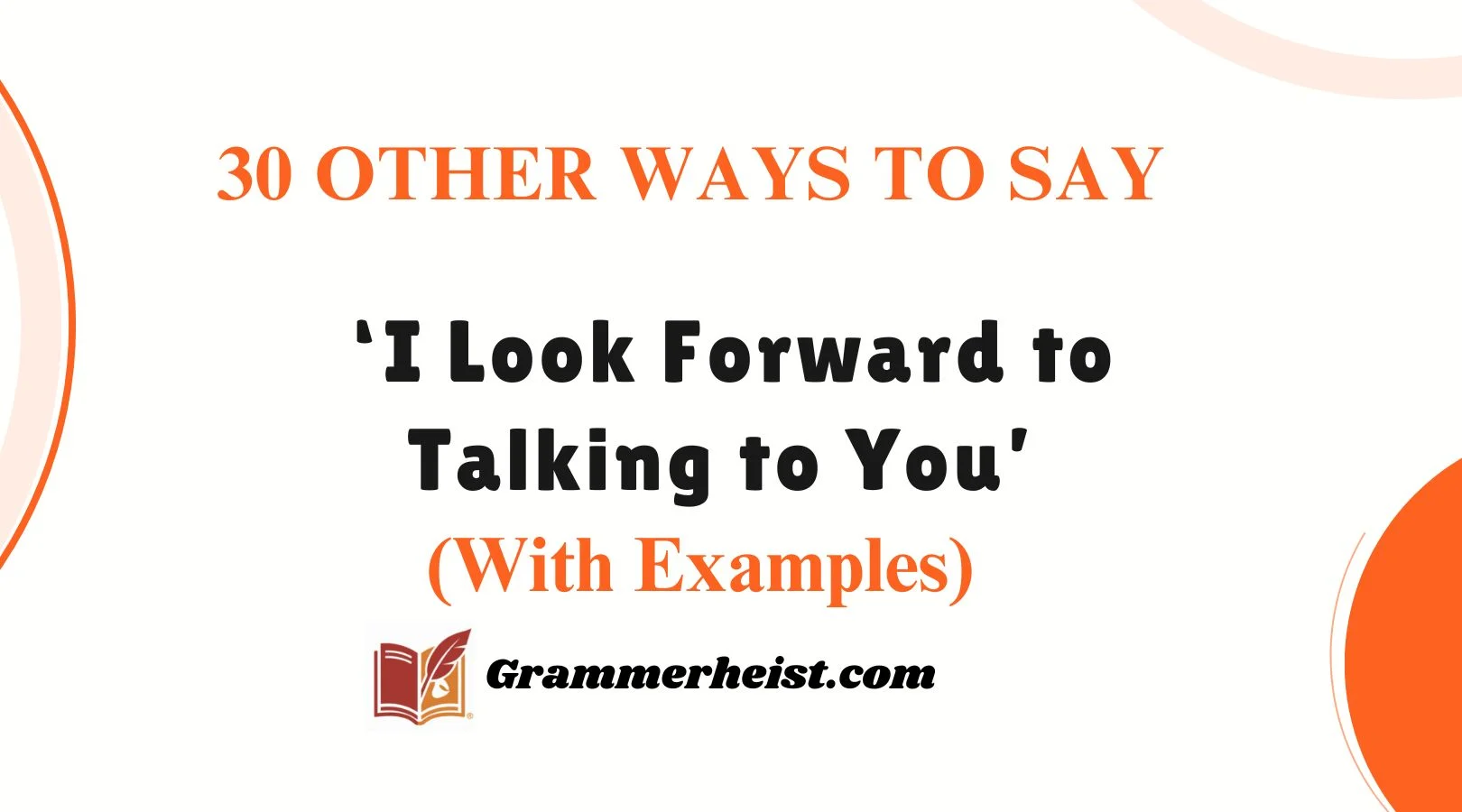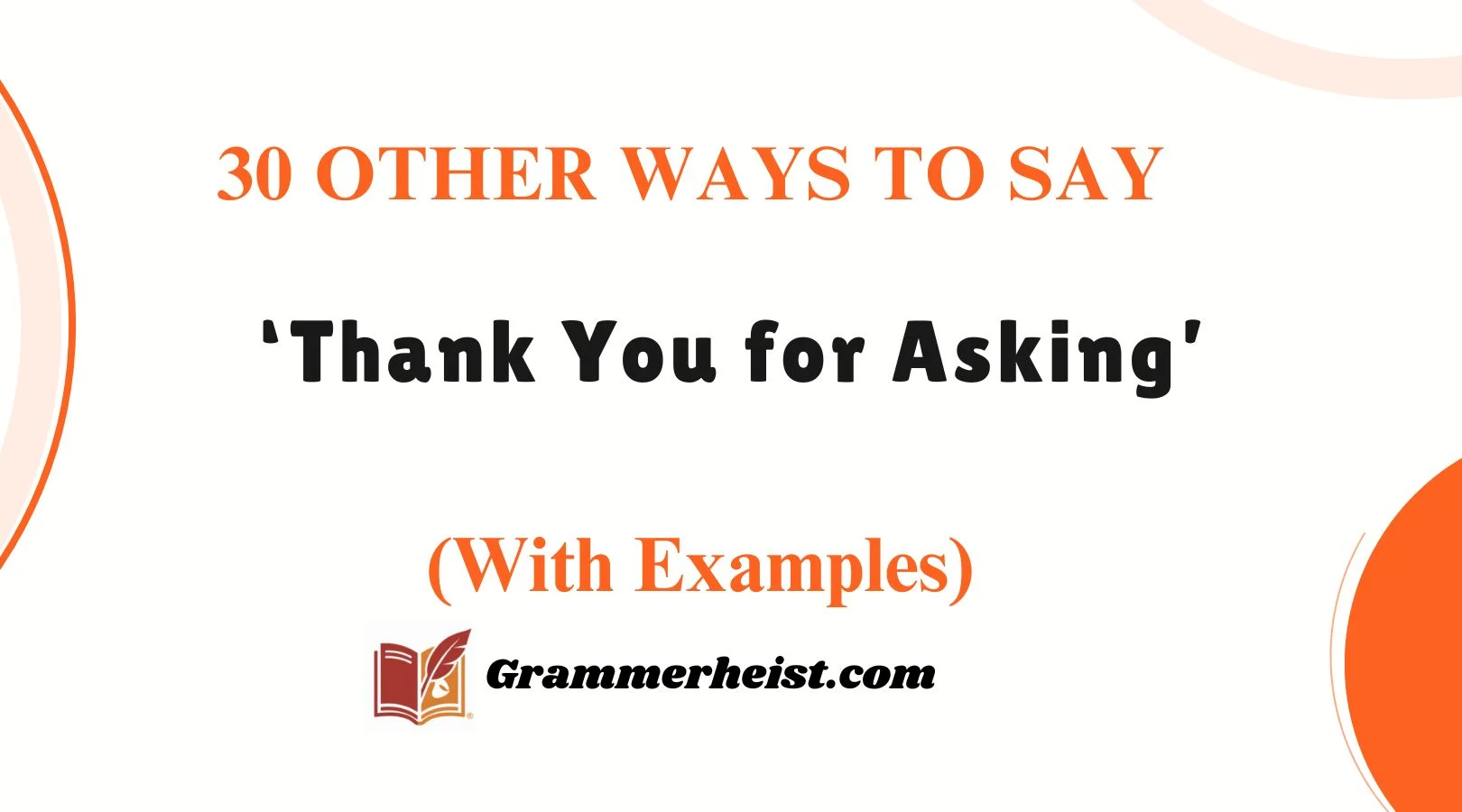When we communicate, the way we express ourselves can make all the difference. Words have power—power to comfort, to clarify, and to connect. When we say “It is my understanding,” we’re usually sharing our perspective, giving someone insight into how we see a situation. But there are many different ways to express this idea—some more formal, some more personal, and some more empathetic.
Finding the right alternative can not only convey your thoughts but can also make your message feel warmer and more meaningful. Here are 30 alternative ways to say “It is my understanding,” each with examples, meanings, and guidance on the best use. Let’s explore these together!
What Does “It Is My Understanding” Mean?
Before diving into alternatives, let’s take a moment to understand what “It is my understanding” means. It’s a phrase often used to indicate that we’re sharing our own perception of a situation. It implies that the speaker is providing an interpretation of the information they have gathered, and they’re careful to note that it’s just their view or comprehension, not a definitive fact.
Is It Professional/Polite to Say “It Is My Understanding”?
Yes, “It is my understanding” is a polite and professional way to express your viewpoint, especially in situations where you might want to clarify something or show that you’re presenting your perspective, rather than stating something as absolute truth. It maintains a tone of respect and openness, showing that you’re open to correction or further input.
Advantages or Disadvantages
Advantage:
- It’s neutral and respectful.
- It shows humility, acknowledging that your interpretation could be different from someone else’s.
Disadvantage:
- It can sound a bit formal or distant in more personal conversations.
- It may imply uncertainty, which can sometimes weaken the clarity of your message.
It Is My Understanding Synonyms:
- I Believe
- As I See It
- In My Opinion
- From My Point of View
- I Understand It To Be
- I Take It That
- It Appears To Me
- It Seems To Me
- I Gather That
- I’m Under the Impression
- I Conclude
- I Perceive
- I Feel
- I Assume
- It’s My Perception
- I Reckon
- I’m Led to Believe
- From What I Can Tell
- I Judge
- Based on What I Know
- It’s My Impression
- I’m Thinking
- It’s My Belief
- I Trust
- My View Is
- I Intuit
- I Can Only Assume
- To My Knowledge
- I’ve Come to Understand
- It’s My Sense
1. I Believe
Meaning: This expression shares a personal conviction or view, making it slightly more subjective than saying “It is my understanding.”
Definition: Used when expressing one’s thoughts or beliefs, often in a more confident tone.
Explanation: By using “I believe,” you’re clearly stating your perspective, giving it a more assertive or confident air.
Scenario Example: “I believe the meeting starts at 10 AM, but I’ll double-check.”
Best Use: Best used when you want to express confidence in your view but with room for further discussion.
Tone: Friendly, confident, thoughtful.
2. As I See It
Meaning: This phrase implies that the speaker is offering their perspective, acknowledging that others might see things differently.
Definition: A casual way of stating your point of view.
Explanation: It suggests that the speaker’s viewpoint is based on their understanding of a situation.
Scenario Example: “As I see it, we should move forward with the project proposal.”
Best Use: Use it when you’re offering a suggestion or viewpoint, but open to hearing others’ thoughts.
Tone: Casual, conversational, flexible.
3. In My Opinion
Meaning: A straightforward and clear way to express one’s perspective.
Definition: This phrase introduces a statement as being subjective, and not a fact.
Explanation: It’s commonly used in discussions or debates to indicate that what follows is a personal view, not a universal truth.
Scenario Example: “In my opinion, we could improve the design by simplifying the layout.”
Best Use: Use it when you’re offering a subjective viewpoint, especially in discussions or brainstorming sessions.
Tone: Direct, open, slightly formal.
4. From My Point of View
Meaning: Similar to “As I See It,” it introduces a personal perspective, often with a slightly more formal undertone.
Definition: A phrase that acknowledges your perspective and subtly reminds others that their viewpoint may differ.
Explanation: This phrase is often used in more structured conversations or presentations to share a personal outlook while remaining professional.
Scenario Example: “From my point of view, the project timeline needs to be adjusted.”
Best Use: Ideal for professional settings when presenting an opinion that may be debated.
Tone: Professional, thoughtful, clear.
5. I Understand It To Be
Meaning: This alternative expresses an understanding or interpretation of a situation, typically used to clarify or provide insight.
Definition: Implies that you’ve processed information and arrived at a conclusion based on your understanding.
Explanation: This phrase suggests that you have gathered facts and are offering your interpretation.
Scenario Example: “I understand it to be a priority that we resolve this issue before the deadline.”
Best Use: Best in formal conversations where you need to provide a reasoned explanation or clarification.
Tone: Professional, clear, neutral.
6. I Take It That
Meaning: This is a slightly more conversational way of stating an understanding or assumption.
Definition: Used to express that you believe something is true, based on the information available to you.
Explanation: It suggests that you’re making an assumption based on what you’ve been told or observed.
Scenario Example: “I take it that we’ll be meeting at 3 PM tomorrow?”
Best Use: Use in informal conversations, particularly when seeking confirmation or clarification.
Tone: Casual, inquisitive, conversational.
7. It Appears To Me
Meaning: A more polite and indirect way of sharing your understanding of a situation.
Definition: Indicates that, based on available information, the speaker has concluded.
Explanation: It suggests a careful or tentative interpretation, often with room for other perspectives.
Scenario Example: “It appears to me that the project is behind schedule.”
Best Use: When you want to share your thoughts without sounding too definitive or dismissive of other viewpoints.
Tone: Gentle, considerate, cautious.
8. It Seems To Me
Meaning: Similar to “It appears to me,” this phrase shares a personal perception but with an added tone of tentativeness.
Definition: Expresses the speaker’s perception, though acknowledging that this might not be the only interpretation.
Explanation: A soft and humble way of presenting an opinion or understanding of a matter.
Scenario Example: “It seems to me that the team could benefit from more communication.”
Best Use: Ideal in conversations where you want to avoid being too blunt or certain, offering a more diplomatic approach.
Tone: Tentative, polite, thoughtful.
9. I Gather That
Meaning: A polite way to say that you’ve come to an understanding through information or conversation.
Definition: Implies that your understanding comes from a series of observations or communications.
Explanation: Suggests that you have processed information but might not have all the details or certainty.
Scenario Example: “I gather that the meeting has been postponed until next week.”
Best Use: Best in professional settings where you are interpreting or summarizing information shared by others.
Tone: Neutral, formal, considerate.
10. I’m Under the Impression
Meaning: Used when you have a certain understanding based on what you’ve heard or perceived, though you’re open to being corrected.
Definition: Implies that you’ve formed a view based on incomplete information or assumptions.
Explanation: This phrase communicates that you may not have all the facts but are operating on your understanding.
Scenario Example: “I’m under the impression that the report is due tomorrow.”
Best Use: Use it when you’re unsure and would like to confirm your understanding.
Tone: Casual, uncertain, open.
11. I Conclude
Meaning: Indicates that you’ve reached a judgment or understanding based on evidence or reasoning.
Definition: A formal way of stating a conclusion derived from thought or analysis.
Explanation: It implies that you’ve carefully considered information and arrived at your understanding.
Scenario Example: “I conclude that the delay was due to unforeseen circumstances.”
Best Use: Ideal in formal discussions or written reports where you need to summarize your reasoning.
Tone: Professional, analytical, thoughtful.
12. I Perceive
Meaning: Suggests that your understanding comes from your observation or experience.
Definition: A formal way to share how something appears to you based on perception.
Explanation: Often used to highlight your subjective understanding without asserting it as fact.
Scenario Example: “I perceive that the team is struggling with the new software.”
Best Use: Best for thoughtful or reflective discussions.
Tone: Reflective, formal, empathetic.
13. I Feel
Meaning: Expresses your understanding with a focus on emotions or intuition rather than logic.
Definition: A casual phrase often used in personal or empathetic conversations.
Explanation: Highlights a subjective and emotion-driven perspective.
Scenario Example: “I feel that this approach might not resonate with the audience.”
Best Use: Use in informal settings or when sharing empathetic or intuitive perspectives.
Tone: Emotional, empathetic, conversational.
14. I Assume
Meaning: Indicates a belief or understanding based on incomplete information.
Definition: Suggests a tentative conclusion that requires confirmation.
Explanation: Acknowledges the possibility of being incorrect while sharing your interpretation.
Scenario Example: “I assume the report will be finalized by Friday.”
Best Use: Use when you’re making a guess or seeking clarification.
Tone: Tentative, neutral, open.
15. It’s My Perception
Meaning: A formal way to share your perspective or understanding of a situation.
Definition: Focuses on how things appear to you, emphasizing subjectivity.
Explanation: Allows you to share your views while respecting differing opinions.
Scenario Example: “It’s my perception that the client prefers a more collaborative approach.”
Best Use: Ideal for professional conversations when explaining your viewpoint.
Tone: Formal, respectful, insightful.
16. I Reckon
Meaning: A casual and slightly regional way of saying you think or believe something to be true.
Definition: Commonly used in informal speech to express a personal viewpoint.
Explanation: Suggest confidence in your understanding but with an informal tone.
Scenario Example: “I reckon we’ll finish the project ahead of schedule.”
Best Use: Best in informal or conversational settings.
Tone: Casual, confident, conversational.
17. I’m Led to Believe
Meaning: Suggests that your understanding is based on information provided by others.
Definition: A polite way of expressing an interpretation influenced by others’ statements.
Explanation: Acknowledges the source of your belief while allowing for the possibility of being misinformed.
Scenario Example: “I’m led to believe that the venue has been changed to a larger location.”
Best Use: Best for situations where your understanding relies on second-hand information.
Tone: Formal, polite, cautious.
18. From What I Can Tell
Meaning: Indicates that your understanding is based on observable facts or available information.
Definition: A conversational way of expressing a conclusion drawn from limited knowledge.
Explanation: Acknowledges the potential for gaps in your understanding.
Scenario Example: “From what I can tell, the team is on track to meet the deadline.”
Best Use: Ideal for informal or semi-formal discussions.
Tone: Friendly, neutral, observational.
19. I Judge
Meaning: Shares a conclusion based on analysis or evaluation.
Definition: A more formal way to state an opinion that has been carefully thought through.
Explanation: Often used in professional contexts where evaluation is required.
Scenario Example: “I judge that the plan aligns with our strategic goals.”
Best Use: Use in formal or professional contexts where you need to show critical thinking.
Tone: Analytical, formal, assertive.
Read More: Other Ways to Say “Happy Anniversary to Husband” (With Examples)
20. Based on What I Know
Meaning: Expresses an understanding rooted in your current knowledge.
Definition: A careful way of stating an opinion while recognizing the possibility of incomplete information.
Explanation: Keeps the tone neutral and open to further clarification.
Scenario Example: “Based on what I know, the project budget has already been approved.”
Best Use: Best in professional settings where you want to balance confidence with openness.
Tone: Neutral, professional, open.
21. It’s My Impression
Meaning: A tentative way of expressing an understanding based on perception or limited information.
Definition: Implies that your viewpoint is shaped by how things appear to you.
Explanation: Often used to soften an opinion or observation.
Scenario Example: “It’s my impression that the team is making great progress.”
Best Use: Use when offering an interpretation or observation in professional or personal settings.
Tone: Polite, reflective, cautious.
22. I’m Thinking
Meaning: Expresses your current thought process or consideration.
Definition: A casual way of indicating an opinion or understanding.
Explanation: Suggests that your thoughts are still forming or evolving.
Scenario Example: “I’m thinking we might need to adjust the timeline for the launch.”
Best Use: Best for informal or brainstorming conversations.
Tone: Casual, open, conversational.
23. It’s My Belief
Meaning: Indicates a strong personal conviction or perspective.
Definition: A formal phrase that conveys confidence in your understanding or opinion.
Explanation: Suggests a deeper or more personal level of certainty.
Scenario Example: “I believe that teamwork is key to this project’s success.”
Best Use: Ideal for formal discussions or when expressing deeply held views.
Tone: Confident, formal, thoughtful.
24. I Trust
Meaning: Suggests that your understanding is based on faith in information or a person.
Definition: A phrase that conveys reliance on the credibility of others.
Explanation: Often used in conversations to show confidence in someone’s words or actions.
Scenario Example: “I trust that the issue has been resolved.”
Best Use: Use when you want to express confidence or support.
Tone: Supportive, positive, reassuring.
25. My View Is
Meaning: A direct way to express your opinion or perspective on a matter.
Definition: States your understanding from a personal perspective.
Explanation: This phrase emphasizes that what follows is a subjective viewpoint, not a universal truth.
Scenario Example: “My view is that we should prioritize customer feedback in our next update.”
Best Use: Best in discussions or meetings where sharing perspectives is encouraged.
Tone: Assertive, clear, conversational.
26. I Intuit
Meaning: Suggests that your understanding comes from intuition or a gut feeling rather than explicit reasoning.
Definition: Expresses a conclusion drawn from instinctive insight.
Explanation: Reflects a subjective and less formal method of understanding.
Scenario Example: “I intuit that the team might need more support to meet the deadline.”
Best Use: Use when offering insights in informal or creative discussions.
Tone: Reflective, informal, empathetic.
27. I Can Only Assume
Meaning: A cautious way to express an understanding based on limited or incomplete information.
Definition: A phrase that highlights the speculative nature of your statement.
Explanation: Suggests that your viewpoint is a reasoned guess rather than a confirmed fact.
Scenario Example: “I can only assume that the document is still being reviewed.”
Best Use: Best in situations where you lack complete clarity and want to avoid sounding definitive.
Tone: Tentative, polite, neutral.
28. To My Knowledge
Meaning: Indicates your understanding based on the information currently available to you.
Definition: A polite way of framing your viewpoint while acknowledging possible gaps in your knowledge.
Explanation: Suggests that you’re open to corrections or updates to your understanding.
Scenario Example: “To my knowledge, the contract has already been signed.”
Best Use: Ideal in professional settings where accuracy is critical.
Tone: Professional, cautious, neutral.
29. I’ve Come to Understand
Meaning: Implies that your understanding is based on a process of learning or observation.
Definition: A thoughtful way of framing your conclusion, often showing growth or reflection.
Explanation: Suggests that your perspective has developed over time or through recent experiences.
Scenario Example: “I’ve come to understand that clear communication is vital for teamwork.”
Best Use: Use in personal or professional conversations when reflecting on a learning process.
Tone: Thoughtful, reflective, empathetic.
30. It’s My Sense
Meaning: Conveys a subtle understanding or feeling about a situation.
Definition: Indicates that your viewpoint is based on perception, intuition, or subtle clues.
Explanation: Often used to share a tentative or exploratory perspective.
Scenario Example: “I sense that the client is leaning toward the second proposal.”
Best Use: Best in conversations requiring tact and subtlety.
Tone: Tentative, sensitive, observational.
Conclusion
Expanding your vocabulary with these 30 alternatives to “It is my understanding” allows you to tailor your tone and style for various situations. Whether you’re aiming for formality, warmth, confidence, or humility, there’s a phrase that fits your needs. These expressions not only enhance clarity but also reflect thoughtfulness and care in your communication.
Choosing the right way to express “It is my understanding” can make your communication feel more personal, thoughtful, and approachable. Whether you want to be confident, cautious, or conversational, the variety of alternatives presented here allows you to adjust your tone and approach depending on the situation. Using these alternatives not only helps you communicate more effectively but also builds stronger connections by reflecting warmth and care in your words.

Theo Jay is a skilled writer and editor with a passion for perfecting the written word. With a strong background in both creative and technical writing, Theo brings a unique approach to grammar and language, blending precision with creativity.



